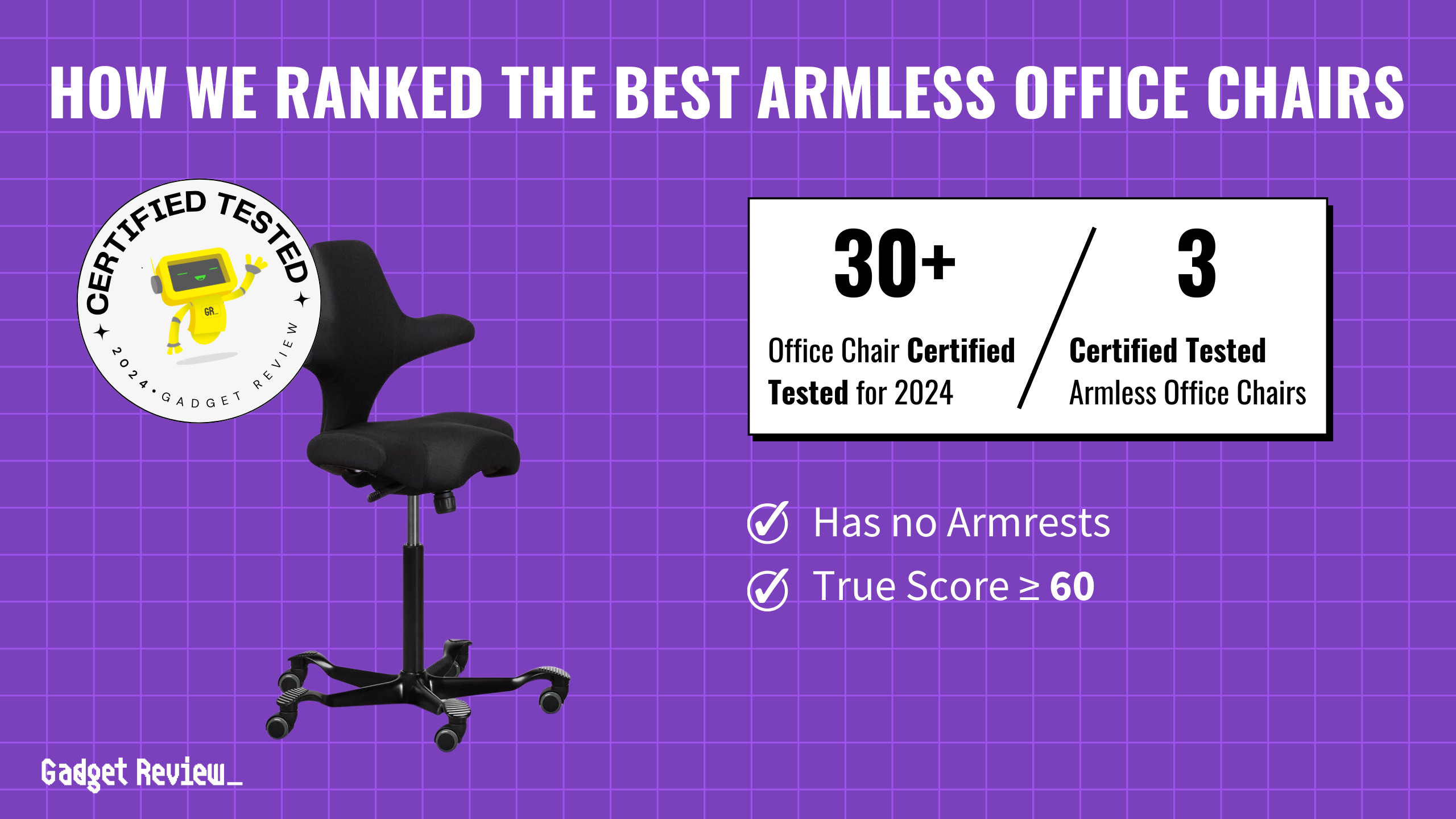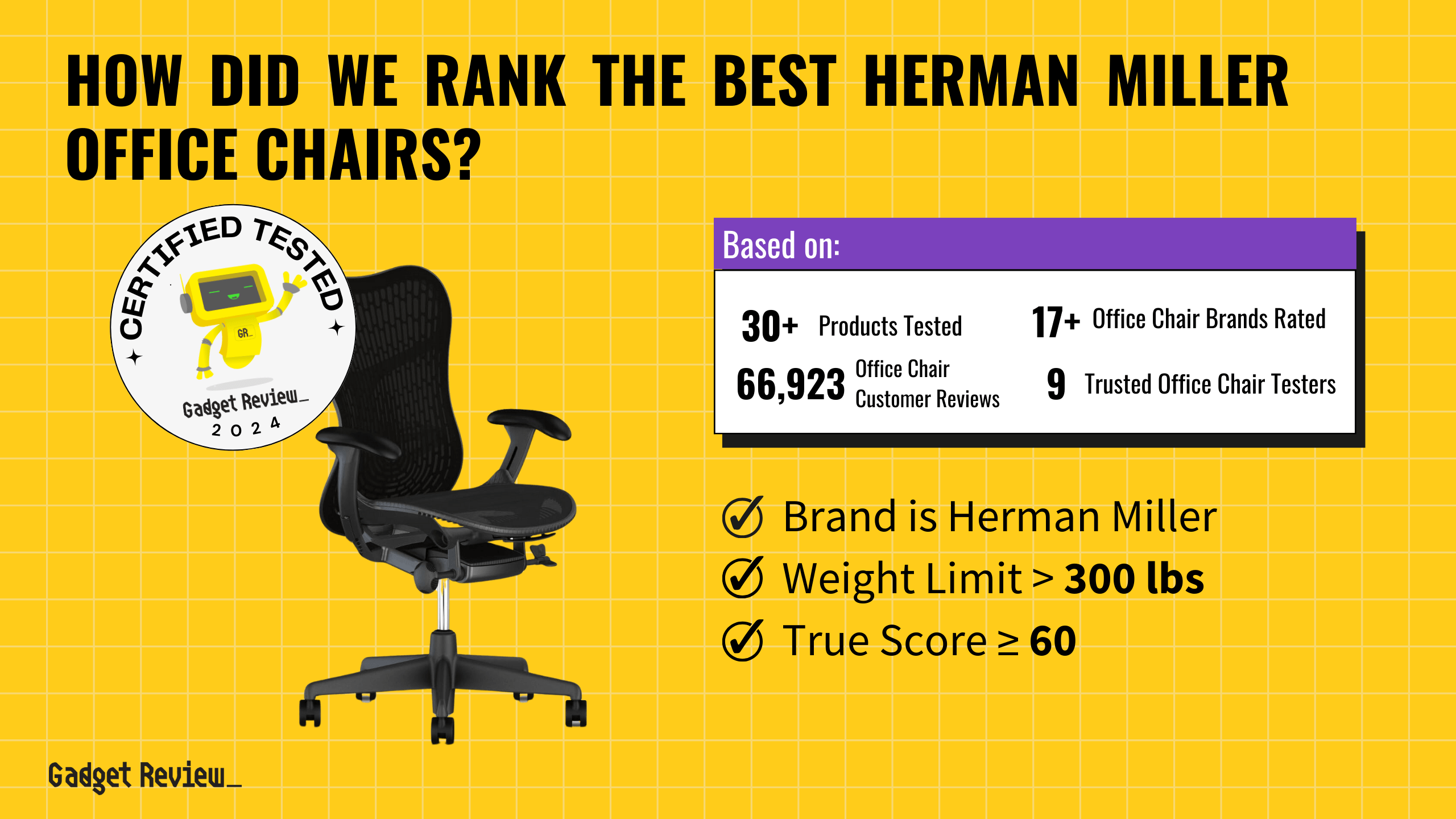When choosing an office chair, it’s crucial to consider features like adjustable lumbar support and a high degree of adjustability, including seat height, armrest, and recline adjustments. These features help you maintain a comfortable and ergonomic posture during long work hours, preventing discomfort and potential back issues. Additionally, the build quality and material choice, such as breathable mesh or high-density foam, can significantly impact your sitting experience, providing the necessary support and durability.
For our buying guide, we analyzed 33 office chairs, narrowing down to 6 that performed exceptionally well in comfort, adjustability, and durability tests. Our comprehensive review process included assessing 67,180 reviews and filtering out 69% of experts who were deemed untrustworthy due to inconsistent or fake reviews. This ensures that our recommendations are based on verified, reliable data, focusing on chairs that genuinely offer the best features and value for a comfortable seating experience.
How Did We Rank the Best Office Chairs?
Office chairs do not have a lot of testing data available, which makes test-focused approaches challenging. Fortunately, office chairs are also in a rather unique position to not need a lot of test data because so much of what impacts them is based on specifications and features. The testing criteria we looked at paint only part of the picture for this list of the office chairs we most recommend – features like materials, measurements, and more all factored in as well.
| CRITERIA | RANGE | REQUIRED | DEFINITION |
|---|---|---|---|
| Maximum Weight Limit | > 300 lbs | No (Nice to have) | How much weight the chair can support. |
| Seat Width | Varies | No (Nice to have) | The width of the seat. |
| Backrest Height | Varies | No (Nice to have) | The height of the chair’s backrest. |
Latest Updates
- 08/06/2024: Republished the list to include the best office chairs based on our True Score system.
Top Office Chairs For 2025
Prices accurate at the time of publishing

Our Approach to Analyzing Office Chairs
We’ve redefined office chair buying guides, setting us apart from any other site on the planet. Our unique approach uses a comprehensive dataset from trusted sites, focusing on key testing metrics like brightness recline angle, seat height, width, and depth.
We aggregate and analyze this data, ensuring our recommendations meet the specific needs. Specifically, when it comes to office chairs, this involves selecting models that offer good adjustability, good recline angles, and sturdy construction.
Which Criteria Matters for Testing Office Chairs?
By focusing on these criteria, anyone can quickly and easily compare these office chairs and how they’ll perform. This helps you make an informed decision and purchase an office chair that will meet your needs.
| CRITERIA | RANGE | REQUIRED | DEFINITION |
|---|---|---|---|
| Maximum Weight Limit | > 300 lbs | No (Nice to have) | How much weight the chair can support. |
| Seat Width | Varies | No (Nice to have) | The width of the seat. |
| Backrest Height | Varies | No (Nice to have) | The height of the chair’s backrest. |
Our Trusted Data Sources
We looked at 80+ office chairs reviewers and while 25 are trustworthy (60%+ Trust Rating), we only use data from the testers that are “very trusted” which means a Trust Rating above 70%. The three we have listed below are our most trusted for office chairs.
- Melanie Pinola – Wirecutter, MuckRack
- Jenny McGraths – Business Insider, MuckRack, Twitter
- Ciprian Adrian Rusen – Digital Citizen, LinkedIn
Interested in a comprehensive analysis of our data sources? We’ve got you covered. Below, you’ll find a detailed list of every office chair review website we’ve identified, organized by their respective Trust Ratings from highest to lowest. But we didn’t stop there. We’ve meticulously reviewed each publication and verified the data by checking whether the authors have bio links to MuckRack or LinkedIn. We’re committed to not only checking the facts but ensuring their veracity.
Office Chair Test Data & Specifications
1. Weight Limit Spec Data
Weight Limit
> 300 lbs
Acceptable range of performance
Definition: How much weight the chair can support.
Units of Measurement: lbs (pounds)
Tools to Measure: Manufacturer-provided specification
Why It’s Important:
Weight limits tell you the rough weight a person can be and still safely and comfortably use a chair.
Manufacturers commonly provide a weight limit specification that lets you know the weight the chair will support before parts start breaking or it becomes unsafe to sit in the chair.
Higher weight limits usually reflect a more expensive chair, as more material (or stronger material) is used to improve the weight limit of the chair. For example, different pistons, or chair legs that are made of metal instead of plastic.
Weight Limit (in pounds; higher is better)
2. Seat Width Spec Data
Seat width is a manufacturer-provided measurement that indicates how wide the actual seat of the chair is.
Width is largely preferential, with the best seat width being the one that best suits your body. Buying a chair with an extremely wide seat might be uncomfortable or odd if you have a narrow frame, while extremely narrow seats are uncomfortable or impossible to sit in if you’re wide.
Seat Width
Varies
Acceptable range of performance
Definition: The width of the seat.
Units of Measurement: ” (Inches)
Tools to Measure: Manufacturer-provided specification.
Why It’s Important:
Seats need to be wide enough to be comfortable to sit in.
Seat Width (in inches)
3. Backrest Height Spec Data
Backrest height is a manufacturer-supplied specification, and, as the name implies, indicates how tall the backrest on a chair is.
Much like seat width, the backrest height on a chair should match your body, meaning there’s no “ideal” size. If you have a long torso, a taller back is better, but if you’re on the short side, a shorter back is better.
Backrest Height
Varies
Acceptable range of performance
Definition: The height of the chair’s backrest.
Units of Measurement: ” (Inches)
Tools to Measure: Measuring Tape
Why It’s Important:
Seat backs need to be high enough to support most or all of your back.
Max Seat Height (in inches; higher is better)
Office Chairs: Mistakes To Avoid
- Overlooking Ergonomic Features and Adjustability: Ergonomics is essential for preventing back pain and promoting good posture. Many people choose chairs based on appearance or price, overlooking ergonomic features. Key features include adjustable lumbar support, armrests, seat height, and tilt mechanisms, allowing customization for different body types and sitting habits. A common mistake is not ensuring the chair offers enough adjustability, which can lead to poor posture and discomfort. Additionally, without proper ergonomic support, you might find yourself sliding out of your office chair, which can be both uncomfortable and disruptive to your workflow. It’s important to test or research the ease and effectiveness of these adjustments.
- Ignoring Seat Comfort and Material: The seat cushion’s comfort and the chair’s material can significantly impact your sitting experience. Some buyers focus solely on the chair’s aesthetics and overlook the quality of the seat padding. A chair with insufficient padding or made from non-breathable materials can lead to discomfort, pressure points, or overheating. Consider chairs with high-quality, durable upholstery and well-padded seats to ensure long-lasting comfort. When choosing a chair, it’s also crucial to weigh the pros and cons of leather vs. mesh chairs and mesh vs. fabric office chairs, as each material offers different benefits in terms of breathability, durability, and comfort.
- Overlooking the Chair’s Base and Mobility: The chair’s base and mobility are important for ease of movement and stability. Some chairs have poor-quality casters that can damage flooring or do not roll smoothly. Additionally, a chair with a five-point base offers more stability than a four-point base. If you need to move around frequently or use multiple surfaces (like carpet and hardwood), ensure the chair has suitable wheels and a stable base. It’s also essential to know how to stop a squeaky chair or address common issues like fixing the chair’s hydraulics to maintain a comfortable and functional seating experience. In addition, knowing how to remove hair from office chair wheels and how to replace the wheels can help maintain the chair’s mobility and extend its lifespan.
- Ignoring the Chair’s Weight Capacity and Size: Many people overlook the importance of choosing a chair that suits their body size and weight. Using a chair not designed for your body type can lead to discomfort and a shorter lifespan for the chair. Check the manufacturer’s specifications for the recommended weight capacity and size guidelines. It’s also important to consider the chair’s dimensions in relation to your workspace to ensure it fits comfortably without crowding your desk or other furniture.
The Best Office Chair Specs Compared
Product |
True Score
|
Backrest Height
|
Seat Width
|
Seat Depth
|
Lumbar Support
|
Adjustable Armrests
| |
|---|---|---|---|---|---|---|---|
| 92 |
|
|
|
|
| $630.00 $1,026 $396 |
| 91 |
|
|
|
|
| $1,236.08 |
| 83 |
|
|
|
|
| $79.98 |
Kerdom Breathable Mesh Office Chair
| 82 |
|
|
|
|
| $149.99 $190 $40 |
| 80 |
|
|
|
|
| $1,149.00 $1,495 $346 |
| 72 |
|
|
|
|
| $361.71 $477 $115 |




























































